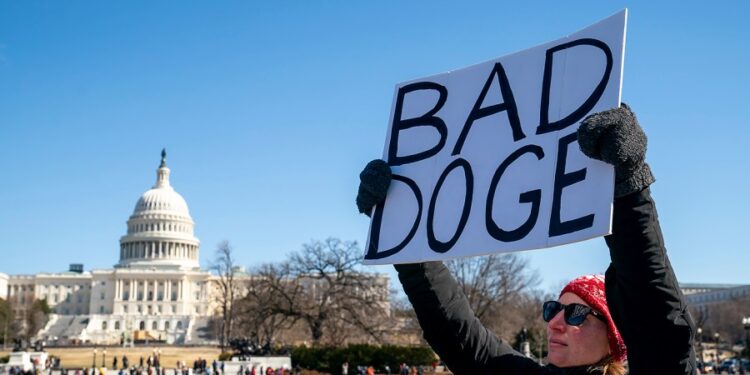
The Department of Government Efficiency is attacking federal government bloat with a fervor seldom seen in our nation’s capital.
The US Agency for International Development has apparently been dismantled. Federal workers have been offered buyouts, which at least 75,000 people have accepted, giving them paid leave through September 2025. Will this aggressive approach work to reduce the federal workforce, while delivering the services that the American population expects and needs from the federal government?
To answer this question, one must look at both the goals and the execution.
The goals are easy to address. DOGE is looking to shrink the federal government and budget. That means shrinking the federal workforce, which stands at around 3 million people. By comparison, the largest private-sector employers in the United States are Walmart (1.6 million) and Amazon (1.1 million).
The 75,000 or more who have accepted the buyout offer represent around 2 percent of the federal workforce. Note that around 1 million people were excluded from this buyout offer, including military personnel, postal workers, air traffic controllers and others contributing to national security. Excluding these workers, the buyout acceptance rate increases to around 3 percent.
Buyouts are used in the private sector to shrink workforces or realign workforce skills based on evolving needs. Some companies may simply fire such people. However, earning a reputation for treating employees poorly does little to attract future workers. The federal buyout is generous — perhaps overly so, which is likely why so many people accepted the offer.
One concern raised is that the people accepting the buyout may be critical contributors, with domain-specific knowledge lost that could take years to recoup. This is true any time senior employees leave an organization. When a generous buyout is offered, low-performing and less skilled people often do not take it because the stable job is a priority for them. Those the organization wishes to retain for their high-skill levels and performance are more likely to jump at the offer, since they have more options outside government. When they are offered a seven-month severance package, it’s an easy decision.
Among the 2 million people eligible for the buyout, natural attrition (retirement and people moving to the private sector) would likely yield at least 100,000 people per year leaving the federal workforce. The buyout is designed to accelerate this, though the seven-month severance package does nothing to yield any real savings.
What would have been more effective is a review of every government agency (top down) coupled with every department within each agency (bottom up) to identify inefficiencies. The problem with such a measured approach is that it would have taken too much time to execute such an orderly downsizing. It would also demand trust in government personnel — something that DOGE appears to lack, based on its goal to end the “tyranny of the bureaucracy.”
Given that the national debt stands at over $36 trillion, growing by over $1 trillion annually, the clock is ticking. Historically, the president’s party has lost seats in the House in nearly every midterm election since Harry Truman was in the White House. Republicans hold only a slim five-seat House majority, which means that Trump’s efforts to reduce government spending and the size of the federal workforce, which he has delegated to DOGE, must be bold, swift and decisive.
Rulings from the judiciary are in process, which could slow or stop DOGE efforts.
The objectives are admirable. The methods are atypical. Government normally changes slowly and methodically, if it changes at all. DOGE’s actions have lacked transparency and may even be illegal. As one commentor noted, the process amounts to “psychological intimidation.”
Of course, many state governments are likely keeping a watchful eye on the situation, as they often suffer the same bloat of the federal government and may follow suit, based on how successful DOGE is. This is particularly true in red states.
As much as most people would like to see the federal debt and deficit brought under control, overcoming the existing structural imbalances will require even more draconian changes than DOGE is seeking. The federal debt interest payments in 2025 will be close to $1 trillion. The $36 trillion national debt is ever-present, with fiscal gymnastics pushing the date when the debt-ceiling limit will be reached out to mid-March.
Entitlement programs like Social Security and Medicare (which are mostly pay as you go) and Medicaid collectively take up over 42 percent of federal spending. In contrast, bringing the federal work force down by 50 percent of the 2 million offered buyouts, or 1 million people, would only save around $150 billion per year, or 2.2 percent of federal spending.
DOGE is an outside-the box idea. Approaching the size of the federal government more thoughtfully would yield better long-term outcomes. Given its approach, this invites the question of whether DOGE is more about disruption than savings. Does it have an ulterior motive that has little to do with reducing our nation’s debt?
And, as the president himself has suggested, do the ends justify the means?
Sheldon H. Jacobson, Ph.D., is a professor of computer science in the Grainger College of Engineering at the University of Illinois Urbana-Champaign. He applies his expertise in data-driven risk-based decision-making to evaluate and inform public policy.







